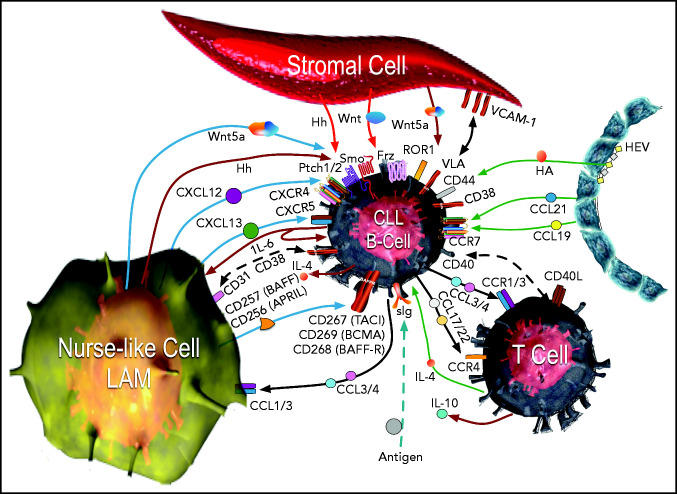Figure 1.
The CLL microenvironment. The main types of accessory cells in the CLL microenvironment are depicted surrounding the CLL B cell, which is located at the center.33 CLL cells enter the lymphoid tissue through HEVs (depicted on the right), which also may elaborate chemokines, such as CCL21 and CCL19, which bind CCR7 and can attract CLL cells. HEVs also produce hyaluronic acid (HA), which can activate CD44 on the CLL cell, as it attaches to HEVs via l-selectin (CD62-L) to egress from the blood (CD62-L). In the bottom left corner is a nurse-like cell (NLC), a lymphoma-associated macrophage (LAM) that secretes a number of chemokines, such as CXCL12 or CXCL13, which bind to CXCR4 or CXCR5, respectively, on the CLL cell, attracting it to the microenvironment. The leukemia cell in turn can elaborate chemokines, such as CCL3 and CCL4, which bind to CCR1 and CCR3 (CCR1/3), or CCL17 and CCL22, which bind CCR4, to recruit T cells (depicted in the bottom right) and monocytes, which are the cells that can differentiate into NLCs. Cognate interactions between CD31 and CD38 on NLCs and CLL cells, respectively, may promote CLL-cell survival. The NLC also expresses proteins of the TNF family, such as BAFF (CD257) and a proliferation inducing ligand (APRIL or CD256), which in turn activate TNF-family receptors such as transmembrane activator and calcium-modulator and cyclophilin ligand (CAML) interactor (TACI or CD267), B-cell maturation antigen (BCMA or CD269), or BAFF-receptor (BAFF-R or CD268) on the CLL cell, inducing activation of nuclear factor κ-light chain B (NF-κB). NLCs and stromal cells (depicted on top) also can produce factors that stimulate the CLL cell, such as various Wingless-related integration site (Wnt) factors, with interact with Frizzled (Frz) receptors, or noncanonical Wnt factors, such as Wnt5a, which can bind and activate ROR1 on the CLL cell. Wnt5a also can activate NF-κB via ROR1 signaling, which induces production of cytokines, such as IL-6, which can stimulate signal transducer and activator of transcription 3 (STAT3) in the CLL cell or NLCs. NLCs and stromal cells may elaborate Hedgehog (Hh) factors, which interact with surface Pitch 1 (Ptch1) and Ptch2, blocking their capacity to inhibit Smoothened (Smo), allowing for activation of the Hedgehog-signaling pathway in the CLL cell. Cognate interactions between surface cell adhesion molecules, such as vascular cell adhesion molecule-1 (VCAM-1 or CD106) on the stromal cell, with CLL integrins, such as very late antigen (VLA), enhances CLL cell survival. Self- or environmental antigen (depicted at the bottom of the figure) that is recognized by the sIg expressed by the CLL cell can lead to activation of the BCR signaling pathway. Cognate interactions between the CLL cell and the T cell in the microenvironment also can involve other TNF-family factors, such as CD40 ligand (CD40L or CD154), which enhance expression of chemokines and cytokines, such as IL-4, that further influence the cellular composition of the microenvironment Collectively, the crosstalk between the CLL cell and the accessory cells within this microenvironment provides the perfect niche to foster leukemia-cell proliferation, forming the so-called proliferation centers within lymphoid tissues of patients with CLL. Adapted from Kipps and Choi80 with permission.

